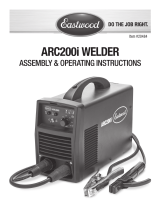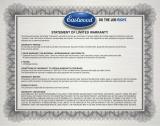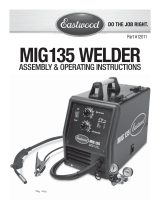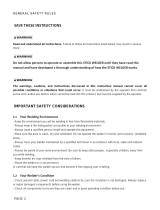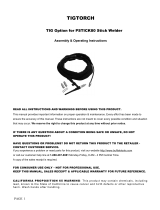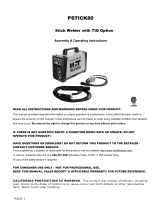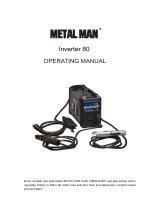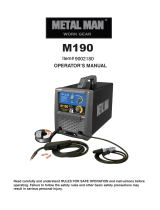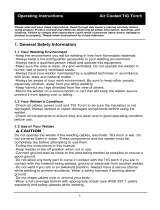Page is loading ...

TIG200 AC/DC WELDER
INS TRUCTIONS
Item #20565

2 Eastwood Technical Assistance: 800.544.5118 >> techelp@eastwood.com
TIG Welding is the most controllable, efficient and most versatile method of welding many metals including steel, stainless steel, aluminum and more. Your
EASTWOOD TIG 200 WELDER with High-Frequency Inverter Technology is capable of welding thin or heavy gauge steel and aluminum with precision and ease.
The Voltage self-sensing circuitry automatically detects a power source range of 110 to 240 Volts and delivers from 10 up to 200 Amps of AC or DC current at
super-high frequency with the added advantage of a light weight unit. The included foot pedal provides the operator with the precise Amperage control required
when welding. A high frequency start feature guarantees an instant arc strike with no tungsten contamination.
STATEMENT OF LIMITED WARRANTY
The Eastwood Company (hereinafter “Eastwood”) warrants to the end user (purchaser) of all new welding and cutting equipment (collectively called the “products”) that it will
be free of defects in workmanship and material. This warranty is void if the equipment has been subjected to improper installation, improper care or abnormal operations.
WARRANTY PERIOD:
All warranty periods begin on the date of purchase from Eastwood. Warranty Periods are listed below, along with the products covered during those warranty periods:
3 Year Warranty on Material, Workmanship, and Defects:
• Eastwood TIG 200 AC/DC Welder
Items not covered under this warranty: Collets, collet bodies, tungsten, nozzles, and ground clamp and cable.
All other components are covered by the warranty and will be repaired or replaced at the discretion of Eastwood.
2 Years:
• All Welding Helmets.
CONDITIONS OF WARRANTY TO OBTAIN WARRANTY COVERAGE:
Purchaser must first contact Eastwood at 1-800-345-1178 for an RMA# before Eastwood will accept any welder returns.
Final determination of warranty on welding and cutting equipment will be made by Eastwood.
WARRANTY REPAIR:
If Eastwood confirms the existence of a defect covered under this warranty plan, Eastwood will determine whether repair or replacement is the most suitable option
to rectify the defect. At Eastwood’s request, the purchaser must return, to Eastwood, any products claimed defective under Eastwood’s warranty.
FREIGHT COSTS:
The purchaser is responsible for shipment to and from Eastwood.
WARRANTY LIMITATIONS:
EASTWOOD WILL NOT ACCEPT RESPONSIBILITY OR LIABILITY FOR REPAIRS UNLESS MADE BY EASTWOOD. EASTWOOD’S LIABILITY UNDER THIS WARRANTY SHALL NOT
EXCEED THE COST OF CORRECTING THE DEFECT OF THE EASTWOOD PRODUCT. EASTWOOD WILL NOT BE LIABLE FOR INCIDENTAL OR CONSEQUENTIAL DAMAGES (SUCH
AS LOSS OF BUSINESS, ETC.) CAUSED BY THE DEFECT OR THE TIME INVOLVED TO CORRECT THE DEFECT. THIS WRITTEN WARRANTY IS THE ONLY EXPRESS WARRANTY
PROVIDED BY EASTWOOD WITH RESPECT TO ITS PRODUCTS. WARRANTIES IMPLIED BY LAW SUCH AS THE WARRANTY OF MERCHANTABILITY ARE LIMITED TO THE
DURATION OF THIS LIMITED WARRANTY FOR THE EQUIPMENT INVOLVED. THIS WARRANTY GIVES THE PURCHASER SPECIFIC LEGAL RIGHTS.
THE PURCHASER MAY ALSO HAVE OTHER RIGHTS WHICH VARY FROM STATE TO STATE.
SPECS
DUTY CYCLE
The Rated Duty Cycle refers to the amount of welding that can be done within an amount of time. The Eastwood TIG 200 has a duty cycle of 60% at 190 Amps.
It is easiest to look at your welding time in blocks of 10 Minutes and the Duty Cycle being a percentage of that 10 Minutes. If welding at 190 Amps with a
60% Duty Cycle, within a 10 Minute block of time you can weld for 6 Minutes with 4 Minutes of cooling for the welder. To increase the Duty Cycle you can
turn down the Amperage Output control. Going above 190 Amps will yield a lower duty cycle.
Function Output
Amperage Range
Maximum Output
No Load Voltage
Input
Voltage
Rated
Duty Cycle
Pre Gas Flow Post Gas Flow Weight Overall
Dimensions
TIG
10-145A
AC/DC
56V DC
120VAC
60% @
145 Amps
0.1-1.0 Sec 2-8 Sec
45 lbs.
[20.4kg]
19.1" [486mm] x
9.8" [248mm] x
20.0" [504mm]
10-200A
AC/DC
220VAC
60% @
190 Amps
STICK
10-140A 120VAC
60% @
140 Amps
NA NA
10-185A 220VAC
60% @
185 Amps

SAFETY INFORMATION
DANGER indicates a hazardous situation which, if not avoided, will result in death or serious injury.
WARNING indicates a hazardous situation which, if not avoided, could result in death or serious injury.
CAUTION used with the safety alert symbol, indicates a hazardous situation which, if not avoided, could result in minor or moderate injury.
NOTICE is used to address practices not related to personal injury.
READ INSTRUCTIONS
• Thoroughly read and understand this manual before using.
• Save for future reference.
ELECTRIC SHOCK CAN CAUSE INJURY OR DEATH!
• Improper use of an electric welder can cause electric shock, injury and death! Read all precautions described in the Welder Manual
to reduce the possibility of electric shock.
• Disconnect welder from power supply before assembly, disassembly or maintenance of the torch, contact tip and when installing or
removing nozzles.
• Always wear dry, protective clothing and leather welding gloves and insulated footwear. Use suitable clothing made from durable
flame-resistant material to protect your skin.
• If other persons or pets are in the area of welding, use welding screens to protect bystanders from sparks.
• Always operate the welder in a clean, dry, well ventilated area. Do not operate the welder in humid, wet, rainy or poorly ventilated
areas.
• The electrode and work (or ground) circuits are electrically “hot” when the welder is on. Do not allow these “hot” parts to come in
contact with your bare skin or wet clothing.
• Separate yourself from the welding circuit by using insulating mats to prevent contact from the work surface.
• Be sure that the work piece is properly supported and grounded prior to beginning an electric welding operation.
• Always attach the ground clamp to the piece to be welded and as close to the weld area as possible. This will give the least
resistance and best weld.
WELDING SPARKS CAN CAUSE FIRE OR EXPLOSION!
• Electric welding produces sparks which can be discharged considerable distances at high velocity igniting flammable or exploding
vapors and materials.
• Do not operate electric arc welder in areas where flammable or explosive vapors are present.
• Do not use near combustible surfaces. Remove all flammable items within 35 feet of the welding area.
• Always keep a fire extinguisher nearby while welding.
• Use welding blankets to protect painted and or flammable surfaces; rubber weather-stripping, dash boards, engines, etc.
• Ensure power supply has properly rated wiring to handle power usage.
ELECTROMAGNETIC FIELDS CAN BE A HEALTH HAZARD!
• The electromagnetic field that is generated during arc welding may interfere with various electrical and electronic devices such as
cardiac pacemakers. Anyone using such devices should consult with their physician prior to performing any electric welding operations.
• Exposure to electromagnetic fields while welding may have other health effects which are not known.
To order parts and supplies: 800.345.1178 >> eastwood.com 3

4 Eastwood Technical Assistance: 800.544.5118 >> techelp@eastwood.com
FUMES & WELDING GASES CAN BE A HEALTH HAZARD!
• Fumes and gasses released during welding are hazardous. Do not breathe fumes that are produced by the welding operation.
Wear an OSHA-approved respirator when welding.
• Always work in a properly ventilated area.
• Never weld coated materials including but not limited to: cadmium plated, galvanized, lead based paints.
BUILDUP OF GAS CAN INJURE OR KILL!
• Shut off shielding gas supply when not in use.
• Ensure adequate ventilation. Do not weld in confined spaces.
• Always turn your face away from valve outlet when opening cylinder valve.
CYLINDERS CAN EXPLODE IF DAMAGED!
Shielding gas cylinders contain gas under high pressure. If damaged, a cylinder can explode. As gas cylinders are a normal component of the
welding process, use extra care to handle them carefully.
• Protect compressed gas cylinders from excessive heat, mechanical shocks, physical damage, slag, open flames, sparks and arcs.
Keep away from any welding or other electrical circuits.
• Install cylinders in an upright position by securing to a specifically designed rack, cart or stationary support to prevent falling or
tipping over.
• Never weld on a pressurized cylinder or explosion will occur.
• Use only correct shielding gas cylinders, regulators, hoses and fittings designed for the specific application; maintain them and all
related components in good condition.
• Keep protective cap in place over valve except when cylinder is in use.
• Use proper equipment, procedures and have adequate help when moving or lifting cylinders.
HOT METAL & TOOLS WILL BURN!
• Electric welding heats metal and tools to temperatures that will cause severe burns!
• Use protective, heat resistant gloves and clothing when using Eastwood or any other welding equipment. Never touch welded work
surface, torch tip or nozzle until they have completely cooled.
ARC RAYS CAN BURN!
• Arc rays produce intense ultraviolet radiation which can burn exposed skin and cause eye damage. Use a shield with the proper filter
(a minimum of #11) to protect your eyes from sparks and the rays of the arc when welding or when observing open arc welding
(see ANSI Z49.1 and Z87.1 for safety standards).
• Use suitable clothing made from durable flame-resistant material to protect your skin.
• If other persons or pets are in the area of welding, use welding screens to protect bystanders from sparks and arc rays.
FLYING METAL CHIPS CAN CAUSE INJURY!
• Grinding and sanding will eject metal chips, dust, debris and sparks at high velocity. To prevent eye injury wear approved
safety glasses.
• Wear an OSHA-approved respirator when grinding or sanding.
• Read all manuals included with specific grinders, sanders or other power tools used before and after the welding process. Be aware of
all power tool safety warnings.
SAFETY INFORMATION

To order parts and supplies: 800.345.1178 >> eastwood.com 5
REQUIRED ITEMS
Before you begin using the Eastwood TIG Welding System, make sure you have the following:
• Our TIG 200 is supplied with the popular NEMA 6-50P plug, requiring a NEMA 6-50R receptacle.
• The TIG 200 will also operate on a 110-120 VAC 20 Amp circuit. To operate on this voltage it is necessary to connect the included adaptor cord
to the plug hard wired to the TIG 200.
• A clean, safe, well-lit, dry and well-ventilated work area.
• A non-flammable, long sleeve shirt or jacket (Eastwood #12762L, XL, XXL).
• Heavy Duty Welding Gloves (#12590)
• An Auto Darkening Welding Mask (Eastwood #13203, #13212, #14425 or equivalent)
to provide eye protection during welding operations. NOTE: MUST be a #11 lens or darker.
• A compressed gas cylinder containing 100% Argon (must be used when TIG welding and is available at any welding supply facility).
• Dedicated stainless steel wire welding brush for each material to be welded.
• A dedicated fine grit synthetic stone grinding wheel or a Tungsten Sharpener.
POWER REQUIREMENTS
The Eastwood TIG 200 AC/DC is Voltage sensing; it will automatically operate on 110-120 VAC, 50/60 Hz., or 220-240 VAC, 50/60 Hz. Eastwood recommends at
a minimum a properly grounded 110-120 VAC 50/60Hz., 20 Amp circuit or 220-240 VAC 50/60Hz., 30 Amp circuit.
BEFORE YOU BEGIN
Remove all items from the box. Compare with list below to make sure unit is complete.
(1) TIG 200 AC/DC Welder with NEMA6-50P Plug
(1) Shielding Gas Regulator
(1) Shielding Gas Hose
(1) Ground Cable with Clamp (10’)
(1) TIG Torch (17 Series) which accepts industry standard cups, collets and collet bodies (14’)
(1) Foot Pedal for Amperage Control
(1) 110-120 VAC to 220-240 VAC Adaptor Plug
(1) Instruction Manual
(1) Hand Held Shield
(1) Hammer/Brush
(1) #7 Gas Nozzle (7/16”)
(1) #6 Gas Nozzle (3/8”)
(1) #5 Gas Nozzle (5/16”) (Installed)
(1) Long Back Cap
(1) Short Back Cap (Installed)
(1) 3/32” Collet Body (Installed)
(1) 3/32” Collet (Installed)
(1) 2mm Collet
(1) 1/16” Collet
(1) 3/32” Red Thoriated Tungsten
(1) 3/32” Green Pure Tungsten

6 Eastwood Technical Assistance: 800.544.5118 >> techelp@eastwood.com
COMPONENTS AND CONTROLS
1. Power Switch – The Power Switch also serves as the overload Circuit Breaker and is located at
the right of the rear panel (FIG. C).
2. Amperage (Front Panel) – Set the Output Amperage Knob marked “A” (FIG. A), located at up-
per left of the top panel, to an appropriate setting based on the thickness and type of the metal
being welded. (Refer to Data Chart for actual settings.)
3. Amperage (Foot Pedal) – Same operation as the panel control but is used while the foot pedal
is in use (FIG. B).
4. Clearance Effect – The Clearance Effect Knob (FIG. A) is located at the upper right of the top
panel. Clearance Effect will control how much cleaning versus penetration occurs. The more
negative the value will result in greater penetration and less cleaning and the more positive the
value will result in less penetration but greater cleaning.
5. Pre Flow – The Pre Flow Knob located at the lower left of the top panel (FIG. A) controls the
time (in seconds) that the shielding gas starts to fl ow after the trigger or foot pedal is pressed
before the arc starts. (Refer to Data Chart for actual settings.)
6. Post Flow – The Post Flow Knob located at the lower right of the top panel (FIG. A) controls
the time (in seconds) that the shielding gas continues to fl ow after the trigger or foot pedal is
released. (Refer to Data Chart for actual settings.)
7. Gas Flow – The included regulator limits the shielding gas fl ow from the bottle and also displays
how much gas is left in the bottle. The Gas Flow Indicator Gauge is located on the left side
and is generally set between 12 to 21 SCFH. (Refer to Data Chart for actual settings.) This is
explained in further detail in the Preparing to Weld section of this manual. The gauge on the right
indicates the pressure left in the tank.
8. AC/DC – The DC setting is used for welding steel and stainless steel while the
AC setting is used for welding aluminum (FIG. A). (Refer to Data Chart for actual settings.)
9. TIG/Stick Switch – The TIG/Stick Switch allows selection between TIG Welding or Stick Weld-
ing confi guration. NOTE: Stick Weld Torch is Not Included.
10. Foot Pedal/Panel Control – The Foot Pedal/Panel Control selection switch is located at the
upper right of the top panel and when set in the ‘Foot Pedal’ position, the Foot Pedal control is
activated. When set to the ‘Panel Control’ position, the Torch Trigger is activated (FIG. A).
11. Torch Switch – The switch on the torch (Fig. D) controls starting and stopping the arc. When
using the torch switch the Amperage is set on the adjustment knob on the front panel of the
welder.
12. Foot Pedal – The foot pedal is for starting and stopping the arc as well as controlling the Am-
perage during the weld. When using the foot pedal the Amperage is set by the adjustment knob
on the side of the foot pedal (FIG. B).
FIG. A
FIG. B
FIG. C
FIG. D
DATA CHART
(
ALSO LOCATED ON TOP OF WELDER
)

To order parts and supplies: 800.345.1178 >> eastwood.com 7
SETUP
SHIELDING GAS CONNECTION
A Shielding Gas Bottle is not included with your Eastwood TIG 200 but is necessary while TIG
welding. A Shielding Gas Bottle can be bought at most local Welding Supply Stores. Eastwood
recommends the use of 100% Argon shielding gas when TIG welding Steel, Aluminum, and
Stainless Steel.
1.
Place the Eastwood TIG 200 in its dedicated area or on a welding cart.
2.
Secure your Shielding Gas Bottle to a stationary object or mount to your welding cart,
if it is equipped to hold one, so that the cylinder cannot fall over.
3.
Remove the cap from the Shielding Gas Bottle.
4.
Insert the large brass male fi tting on the Shielding Gas Regulator into the female fi tting on
the Shielding Gas Bottle
(FIG. E)
.
5.
Tighten the fi tting with a wrench till snug, do not over tighten.
6.
Connect either end of the Gas Line included with your Eastwood TIG 200 to the fi tting on
the regulator and tighten with a wrench until snug.
7.
Connect the other end of the gas line to the fi tting on the rear of the
Eastwood TIG 200 and tighten with a wrench until snug
(FIG. F)
.
TORCH CONNECTION
1.
Install the plastic connection cover onto the brass torch fi tting on the torch cable.
2.
Connect the female brass fi tting on the torch cable to the male brass fi tting on the
welder
(FIG. G)
.
3.
Use a wrench and tighten until snug. DO NOT OVERTIGHTEN.
4.
Connect the black 5 pin plug to the Torch Switch/Foot Pedal Connection as shown in
(FIG. G)
.
NOTE:
Omit this step if you will be using the foot pedal for Amperage control.
GROUND CABLE CONNECTION
1.
Locate the Ground Cable and Clamp.
2.
The Ground Cable connection is located at the far right of the front panel as shown in
(FIG. G)
. With the Key on the connector in the 12 O’clock position,
insert the connector and turn 180° clockwise to lock in the connector.
FOOT PEDAL CONNECTION
1.
If you are going to be using the switch on the torch to start the welding arc, omit this step.
2.
Connect the Black 5 pin plug on the Foot Pedal to the Torch Switch/Foot Pedal Connection as shown in
(FIG. G)
.
STICK WELD CONNECTION WITH OPTIONAL 20517 EASTWOOD STICK WELD TORCH.
1.
Disconnect and remove the TIG Torch/Foot Pedal Connections if in place.
2.
Insert the BLACK Stick Weld Connector into the BLACK Stick Weld Connection located at the far left of the Front Panel
(FIG. F)
. With the Key of the
Connector at the 12:00 position, push in and rotate 180° Clockwise to lock the connector in.
3.
Insert the RED Ground Connector into the RED Ground Connection located at the far right of the Front Panel
(FIG. F)
. With the Key of the Connector at the
12:00 position, push in and rotate 180° Clockwise to lock the connector in.
NOTE:
The above connections are the standard default for Stick Welding.
If your material or rod preference dictates it, the Stick Weld and Ground Connections may safely be reversed.
FIG. E
FIG. F
FIG. G
Ground
Cable
TIG
Torch
Switch/Foot
Pedal
Stick
Torch
Gas Flow
Through
Power
Cable
✓
✓
✓
✓
BUILDUP OF GAS CAN INJURE OR KILL!
Shut off shielding gas supply when not in use.
Ensure adequate ventilation. Do not weld in confi ned spaces.
Always turn your face away from valve outlet when opening cylinder valve.
ELECTRIC SHOCK CAN CAUSE INJURY OR DEATH!
Disconnect Welder from power supply before assembly or disassembly
of Torch and Cables.

8 Eastwood Technical Assistance: 800.544.5118 >> techelp@eastwood.com
PREPARING TO TIG WELD
TORCH DISASSEMBLY
1. Make sure the welder is turned off and unplugged.
2. Remove the back cap from the torch.
3. If there is a tungsten installed in the torch pull
it out of the front of the torch
4. Slide the collet out of the torch.
5. Unscrew and remove the gas nozzle.
6. Unscrew and remove the collet body.
TORCH ASSEMBLY
1. Select a collet body that matches your tungsten diameter size and thread it back into the front of the torch.
2. Select a collet that matches your tungsten diameter size. Insert the tungsten into the collet and put the collet and tungsten back into the torch.
3. The Gas Nozzle size should be selected according to shielding gas requirements for the material being welded.
This size can be referenced on the suggested settings chart. Select the correct gas nozzle and thread it onto the collet body.
4. Reinstall the back cap to lock the tungsten in place. Always make sure the tungsten protrudes 1/8” to 1/4” beyond the gas nozzle.
SHARPENING THE TUNGSTEN
To avoid contamination of the Tungsten and ultimately the weld, it is imperative to have a dedicated
grinding wheel used for Tungsten grinding only. A fi ne grit standard 6” synthetic stone grinding
wheel on a bench top grinder is suffi cient, or specifi cally designed Tungsten Grinders are available.
1. Shut off the welder.
2. Make sure the Tungsten and Torch are suffi ciently cooled for handling, then loosen and
remove the Back Cap then the Collet (FIG. H) and remove the Tungsten from the FRONT of
the Torch only (Removing from the rear will damage the Collet).
3. If the Tungsten is used and the end is contaminated, use pliers or a suitable tool to grip the
tungsten above the contaminated section and snap off the end of the Tungsten.
4. Holding the Tungsten tangent to the surface of the grinding wheel, rotate the Tungsten while
exerting light pressure until a suitable point is formed (FIG. I).
5. The ideal tip will have the length of the conical portion of the sharpened area at 2-1/2 times the Tungsten rod diameter (FIG. J).
6. Replace the Tungsten in the Collet with the tip extending 1/8”-1/4”
beyond the Gas Nozzle, then re-tighten the Back Cap.
FIG. I
FIG. J
Gas Nozzle
Collet Body
Collet
Back Cap
Tungsten
FIG. H
✓
✓
✓
✓
✓
ELECTRIC SHOCK CAN CAUSE
INJURY OR DEATH!
Disconnect Welder from power supply before
assembly or disassembly of Torch and Cables.
FLYING METAL CHIPS CAN CAUSE INJURY!
Grinding and sanding will eject metal chips, dust, debris and sparks at high
velocity. To prevent eye injury wear approved safety glasses.
Wear an OSHA-approved respirator when grinding or sanding.
Read all manuals included with specifi c grinders, sanders or other power
tools used before and after the welding process. Be aware of all power tool
safety warnings.

To order parts and supplies: 800.345.1178 >> eastwood.com 9
SETTINGS SELECTION
With the materials selected of which you will be welding you can begin to set up the welder for the specific material.
1. AC/DC – The type of current will need to be selected depending on the type of material being welded. For the most part when welding steels the switch
will be set to DC and when welding aluminum the switch will be set to AC.
2. Clearance Effect – This step can be omitted if welding in DC. If welding in AC this will need to be set. The more negative the value will result in greater
penetration and less cleaning and the more positive the value will result in less penetration but greater cleaning. For suggested settings refer to the data
chart on the welder.
3. Foot Pedal/Panel Control – Determine whether you will be using the switch on the torch or the foot pedal for arc starting and stopping and put the
selector switch in the appropriate position. Note that some connections changes will be necessary also when switching the control type. These connection
changes are covered in the Set-Up section of this manual.
4. Amperage – If welding using the switch on the torch to control the arc, set the Output Amperage Knob marked “A” (FIG. A) located at upper left of the top
panel to an appropriate setting based on the thickness and type of the metal being welded. (Refer to Data Chart for actual settings). If welding using
the foot pedal to control the arc, it uses the same operation as the panel control but is adjusted on the side of the foot pedal rather than the front panel
(FIG. A).
5. Pre Flow – This adjustment controls the time (in seconds) that the shielding gas starts to flow before the arc starts.
(Refer to Data Chart for actual settings).
6. Post Flow – This adjustment controls the time (in seconds) that the shielding gas flows after the arc stops.
(Refer to Data Chart for actual settings).
7. Power Switch – Once all of the settings have been selected and the torch is assembled and ready to use, the welder can be plugged in and turned on.
8. Shielding Gas Flow – Set the Gas Flow Rate to the appropriate value with the Knob located at the left side of the regulator.
SHIELDING GAS FLOW ADJUSTMENT
After connecting your Shielding Gas Regulator, the gas flow rate needs to be adjusted so that the proper amount of Shielding Gas is flowing over your weld. If
there is too little gas flow there will be porosity in your welds as well as excessive spatter, if there is too much gas flow you will be wasting gas and may affect
the weld quality. The included regulator has 2 gauges on it; the gauge on the left is your flow rate while the gauge on your right is your tank pressure.
1. Open your Shielding Gas tank valve all the way.
2. Adjust the knob on the regulator to ~20 CFH.
3. Turn on the welder and trigger the torch switch or foot pedal which will start the gas flow.
4. As you trigger the torch switch or foot pedal, you will notice that as the gas flow starts the needle on the gauge drops to a steady reading. The reading
while flowing is the value you want to read.
5. The gas flow should be set to 12-21 CFH while flowing depending on the material and thickness being welded. The CFH (Cubic Feet per Hour) scale is the
inside scale in red on your flow gauge. 20 CFH is the most typical flow rate but it may need to be adjusted in some cases depending if there is a slight
breeze or some other instance where additional shielding gas is required to prevent porosity in the weld.
6. When finished welding remember to close the gas valve on the bottle.
BUILDUP OF GAS CAN INJURE OR KILL!
Shut off shielding gas supply when not in use.
Ensure adequate ventilation. Do not weld in confined spaces.
Always turn your face away from valve outlet when opening cylinder valve.

10 Eastwood Technical Assistance: 800.544.5118 >> techelp@eastwood.com
TIG WELDING
IMPORTANT NOTE: These instructions are intended only to provide the user with some familiarity of the Eastwood TIG 200. TIG welding is a highly complex proce-
dure with many variables. If you have no experience with TIG welding; it is extremely important to seek the advice of someone experienced in TIG welding for instruc-
tion, enroll in a local technical school welding course or study a comprehensive how-to DVD and obtain a good quality reference book on TIG welding as there is a
moderate learning curve necessary before achieving proficiency in TIG Welding. Before attempting to use this unit on an actual project or object of value, practice on
a similar material as there are many variables present and settings required when TIG welding different metals such as steel or aluminum. It is also strongly recom-
mended that the user adhere to the American Welding Society guidelines, codes and applications prior to producing welds where safety is affected.
WELDING SPARKS CAN CAUSE FIRE OR EXPLOSION!
Electric welding produces sparks which can be discharged considerable distances at high velocity igniting flammable or exploding
vapors and materials.
Do not operate electric arc welder in areas where flammable or explosive vapors are present.
Do not use near combustible surfaces. Remove all flammable items within 35 feet of the welding area.
Always keep a fire extinguisher nearby while welding.
Use welding blankets to protect painted and or flammable surfaces; rubber weather-stripping, dash boards, engines, etc.
Ensure power supply has properly rated wiring to handle power usage.
HOT METAL & TOOLS WILL BURN!
Electric welding heats metal and tools to temperatures that will cause severe burns!
Use protective, heat resistant gloves and clothing when using Eastwood or any other welding equipment. Never touch welded work surface,
torch tip or nozzle until they have completely cooled.
FUMES & WELDING GASES CAN BE A HEALTH HAZARD!
Fumes and gasses released during welding are hazardous. Do not breathe fumes that are produced by the welding operation.
Wear an OSHA-approved respirator when welding.
Always work in a properly ventilated area.
Never weld coated materials including but not limited to: cadmium plated, galvanized, lead based paints.
ARC RAYS CAN BURN!
Arc rays produce intense ultraviolet radiation which can burn exposed skin and cause eye damage. Use a shield with the proper filter
(a minimum of #11) to protect your eyes from sparks and the rays of the arc when welding or when observing open arc welding
(see ANSI Z49.1 and Z87.1 for safety standards).
Use suitable clothing made from durable flame-resistant material to protect your skin.
If other persons or pets are in the area of welding, use welding screens to protect bystanders from sparks and arc rays.
ELECTRIC SHOCK CAN CAUSE INJURY OR DEATH!
Improper use of an electric welder can cause electric shock, injury and death! Read all precautions described in the Welder Manual
to reduce the possibility of electric shock.
Disconnect welder from power supply before assembly, disassembly or maintenance of the torch, contact tip and when installing
or removing nozzles.
Always wear dry, protective clothing and leather welding gloves and insulated footwear. Use suitable clothing made from durable
flame-resistant material to protect your skin.
If other persons or pets are in the area of welding, use welding screens to protect bystanders from sparks.
Always operate the welder in a clean, dry, well ventilated area. Do not operate the welder in humid, wet, rainy or poorly ventilated areas.
The electrode and work (or ground) circuits are electrically “hot” when the welder is on. Do not allow these “hot” parts to come in
contact with your bare skin or wet clothing.
Separate yourself from the welding circuit by using insulating mats to prevent contact from the work surface.
Be sure that the work piece is properly supported and grounded prior to beginning an electric welding operation.
Always attach the ground clamp to the piece to be welded and as close to the weld area as possible. This will give the least
resistance and best weld.

To order parts and supplies: 800.345.1178 >> eastwood.com 11
FIG. J
FIG. K
FIG. L
75°
90°
1.
Turn the Power Switch/Circuit Breaker to the on position.
2.
Slowly open the gas cylinder valve.
NOTE: Always open valve fully to avoid shielding gas leakage.
3.
Depress gun trigger switch or foot pedal and adjust the flow regulator.
(Refer to Data Chart for actual settings).
4.
Grounding is very important, place the Ground Cable Clamp on a clean, bare area of your work
piece as close to the welding area as possible to minimize the chance of shock. Scrape, wire
brush, file or grind a bare area to achieve a good ground to assure safety.
5.
Use a dedicated stainless steel brush or flap-disc to clean the areas to be welded. This is
particularly critical on aluminum as a microscopic layer of oxidation can prevent an arc and
actually produce a poor-quality, contaminated weld. Do not use the brush or flap-disc for any
other purpose and keep one for steel and one for aluminum.
6.
Make sure all your safety gear is in place (Welding Mask, Welding Gloves, Non-Flammable
Long Sleeve Apparel) and the area is completely free of flammable material.
7.
Although it is a matter of developing a personal style, a good starting point for best results
is achieved by holding the tip at a 75° angle. Hold the Filler Metal Rod at a 90° angle to the
Tungsten Tip (FIG. J). Never allow the Tungsten Tip to touch the welding surface or material
rod. Doing so will quickly destroy the tip and contaminate the weld. If this happens, remove
the Tungsten and regrind the tip. It is best to hold the Tungsten 1/8” from the surface.
8.
With your Welding Shield and all safety gear in place, depress the foot pedal or trigger and
practice “Forming A Puddle” with the Tungsten Tip. Once you become familiar with this step.
Practice the “Dip and Pull” technique with the Filler Metal Rod and Torch. “Dip and Pull” is
the practice of forming a puddle, moving the torch while maintaining the puddle and adding
filler rod metal to the puddle by “dipping and pulling” as you go; being careful not to allow the
Tungsten to contact the puddle or rod.
9.
Keep in mind that you MUST let the shielding gas flow over the weld after releasing the
trigger or pedal. Failure to do so will allow the welded area to oxidize compromising the weld
integrity.
10.
Constantly be aware that TIG welding quickly generates heat in the work piece and torch.
Severe burns can quickly occur by contacting hot metal pieces.
11.
When done, shut off the Power Switch and close the Shielding Gas Tank valve completely.

12 Eastwood Technical Assistance: 800.544.5118 >> techelp@eastwood.com
WELDER CARE & MAINTENANCE
• Constantly inspect the torch tip for excessive erosion, molten metal accumulation burning. If damaged, it must be replaced.
• Before each use, inspect ALL electrical connections, cables, supply line, torch, air supply, housing and controls for damage. If any damage or wear is
noted, DO NOT USE THE UNIT.
• If the welder requires service, it should be performed by a certified repair facility using only authorized replacement parts to maintain full safety and
performance integrity of the welder.
• Always store the unit in a safe, clean and dry environment.
TORCH MAINTENANCE
The Eastwood TIG 200 has a number of consumable parts that will need to be replaced over time. If wear or slag build up is noticed on any of the torch compo-
nents, replace them immediately to avoid damage to the torch. Worn components will also contribute to poor performance. See the torch components
(FIG. H)
exploded view for a reference of all of the components and the assembly order.
ELECTRIC SHOCK CAN CAUSE INJURY OR DEATH!
Disconnect welder from power supply before assembly, disassembly or maintenance of the torch, contact tip and when installing
or removing nozzles.

To order parts and supplies: 800.345.1178 >> eastwood.com 13
TIG TROUBLESHOOTING
Problem Cause Fix
IncompleteCircuit
CheckGroundconnection.Makesurethatthegroundisona
freshlycleanedsurfaceandclosetotheweldingarea.Itis
suggestedtoweldtowardsthegroundconnection.
IncorrectTungsten
Consultchartforpropertungstenforthebasemetalbeing
welded.InmostcasesPureTungstenwillbeforaluminum
andThoriatedwillbeforsteel.
Noshieldinggas
Makesuretheshieldinggascylinderisturnedalltheway
openandsetatthecorrectflowrate.
WrongPolarity
Makesurepolarityissetforthecorrectmaterial.ACshould
beusedforaluminumwhileDCshouldbeusedforsteel.
Poorlypreppedtungsten Followguidelinesforpreppingtungsten.
PoorGasFlow
Adjusttheflowrateoftheshieldinggas(refertosettings
chart).Checkforloosefittingswheregascouldbeleaking.
ContaminatedTungsten
Removetungstenfromtorchandbreakoffcontaminated
sectionandresharpen.
Incorrectarclength
Makesurethetungstenisheld1/8to1/4inchoffthework
piece.
Incompletecircuit
CheckGroundconnection.Makesurethatthegroundisona
freshlycleanedsurfaceandclosetotheweldingarea.Itis
suggestedtoweldtowardsthegroundconnection.
Contaminatedbasemetal
Cleanbasemetalmakingsuretoremoveanyoil,debris,
coatings,ormoisture.Ifbasemetalisaluminummakesureall
oftheoxideisremovedusingeitheradedicatedstainless
brushorflapwheel.
IncorrectClearanceEffect(AC)
ShiftmorenegativeontheClearanceEffectknobsolessheat
isgoingintothetungsten.
PoorGasFlow
Adjusttheflowrateoftheshieldinggas(refertosettings
chart).Checkforloosefittingswheregascouldbeleaking.
Contaminatedfillermetal
Cleanfillermetalmakingsuretoremoveanyoil,debris,or
moisture.
Contaminatedbasemetal
Cleanbasemetalmakingsuretoremoveanyoil,debris,
coatings,ormoisture.
PoorShielding
Makesuretobeinanareawithnowindandwithanyfans
turnedoff.Windorfanswillblowtheshieldinggasawayfrom
theweldcausingporosity.
IncorrectTungstenStickOut
Adjustthetungstensothat1/8to1/4inisstickingoutofthe
collet.
ContaminatedTungsten
Removetungstenfromtorchandbreakoffcontaminated
sectionandresharpen.
ContaminatedFillerMetal
Cleanfillermetalmakingsuretoremoveanyoil,debris,or
moisture.
ContaminatedBaseMetal
Cleanbasemetalmakingsuretoremoveanyoil,debris,
coatings,ormoisture.Ifbasemetalisaluminummakesureall
oftheoxideisremovedusingeitheradedicatedstainless
brushorflapwheel.
PoorGasFlow
Adjusttheflowrateoftheshieldinggas(refertosettings
chart).Checkforloosefittingswheregascouldbeleaking.
ImproperClearanceEffect(AC)
ShiftmorenegativeontheClearanceEffectknobsolessheat
isgoingintothetungsten.
WrongSizeTungsten Increasetungstendiameter.Refertochartforpropersizing.
Notenoughpostflow Increasepostflowtimetoallowthegastocoolthetungsten.
IncorrectShieldingGas Onlyuse100%ArgonwhenTIGWelding.
LowVoltage
Voltagesettingistoolowformaterial/thickness.Increaseas
neededandreferencechartonwelder.
IncorrectClearanceEffect(AC)
Shifttheclearanceeffectmoretothenegativesideasthiswill
transfermoreheattothematerialbeingwelded.
PoorPenetration(Steel)
LowVoltage
Voltagesettingistoolowformaterial/thickness.Increaseas
neededandreferencechartonwelder.
TungstenContaminated
ContactofTungstenwithBase
Metal
Keeptungsten1/8to1/4inchfromthebasemetal.If
tungstencomesincontactbreakoffendandresharpen
immediately.
PoorWeldAppearance
Incorrectpositioning
Theanglebetweenthefillermetalandthetorchmustbeless
than90degreesotherwisethefillermetalwillprematurely
meltandgloboffcausingpoorweldappearance.
InsuficcientShielding
Keepthetorchonthebasemetalwhilethepostflow
shieldinggasflowstoprotectandcoolthemetaland
tungsten.
NotEnoughFillerMaterial
Reducecurrentwithpedelandaddmorefilleratendofweld.
Itmayalsobebenficaltobacksteptoensurenocraterwill
form.
Toomuchheatinmaterial Reduceheatandallowmoretimebetweenpasses.
BaseMetalisabsorbingtoomuch
heat
Preheatbasemetal(consultweldingcodesforrequirments)
IncorrectFillerWire Reducefillerwiresize.
InsufficentClamping Clampworkpiecetightlyandweldwhileclampsareinplace.
InsufficentTackWelds Addmoretackweldsuntilrigidityandstiffnessisdeveloped.
TooMuchHeatinMaterial
Toreduceheatitisbesttospreadtheweldingoutaroundthe
area.Thiscanbedonebyusingstitchweldingtechniques,
alternatingsides,and/ortakingyourtimeandallowingthe
piecestocoolbetweenpasses.
Arcistriggeredbutwillnotstart
Porosityinweldbead
CraterintheEndoftheWeldBead
WeldBeadisCracking
MaterialisWarping
PoorPenetration(Aluminum)
Arcwandersanditishardtoconcentrate
heatinaspecificarea
Contaminationinweldbead
MeltingTungsten
Problem Cause Fix
IncompleteCircuit
CheckGroundconnection.Makesurethatthegroundisona
freshlycleanedsurfaceandclosetotheweldingarea.Itis
suggestedtoweldtowardsthegroundconnection.
IncorrectTungsten
Consultchartforpropertungstenforthebasemetalbeing
welded.InmostcasesPureTungstenwillbeforaluminum
andThoriatedwillbeforsteel.
Noshieldinggas
Makesuretheshieldinggascylinderisturnedalltheway
openandsetatthecorrectflowrate.
WrongPolarity
Makesurepolarityissetforthecorrectmaterial.ACshould
beusedforaluminumwhileDCshouldbeusedforsteel.
Poorlypreppedtungsten Followguidelinesforpreppingtungsten.
PoorGasFlow
Adjusttheflowrateoftheshieldinggas(refertosettings
chart).Checkforloosefittingswheregascouldbeleaking.
ContaminatedTungsten
Removetungstenfromtorchandbreakoffcontaminated
sectionandresharpen.
Incorrectarclength
Makesurethetungstenisheld1/8to1/4inchoffthework
piece.
Incompletecircuit
CheckGroundconnection.Makesurethatthegroundisona
freshlycleanedsurfaceandclosetotheweldingarea.Itis
suggestedtoweldtowardsthegroundconnection.
Contaminatedbasemetal
Cleanbasemetalmakingsuretoremoveanyoil,debris,
coatings,ormoisture.Ifbasemetalisaluminummakesureall
oftheoxideisremovedusingeitheradedicatedstainless
brushorflapwheel.
IncorrectClearanceEffect(AC)
ShiftmorenegativeontheClearanceEffectknobsolessheat
isgoingintothetungsten.
PoorGasFlow
Adjusttheflowrateoftheshieldinggas(refertosettings
chart).Checkforloosefittingswheregascouldbeleaking.
Contaminatedfillermetal
Cleanfillermetalmakingsuretoremoveanyoil,debris,or
moisture.
Contaminatedbasemetal
Cleanbasemetalmakingsuretoremoveanyoil,debris,
coatings,ormoisture.
PoorShielding
Makesuretobeinanareawithnowindandwithanyfans
turnedoff.Windorfanswillblowtheshieldinggasawayfrom
theweldcausingporosity.
IncorrectTungstenStickOut
Adjustthetungstensothat1/8to1/4inisstickingoutofthe
collet.
ContaminatedTungsten
Removetungstenfromtorchandbreakoffcontaminated
sectionandresharpen.
ContaminatedFillerMetal
Cleanfillermetalmakingsuretoremoveanyoil,debris,or
moisture.
ContaminatedBaseMetal
Cleanbasemetalmakingsuretoremoveanyoil,debris,
coatings,ormoisture.Ifbasemetalisaluminummakesureall
oftheoxideisremovedusingeitheradedicatedstainless
brushorflapwheel.
PoorGasFlow
Adjusttheflowrateoftheshieldinggas(refertosettings
chart).Checkforloosefittingswheregascouldbeleaking.
ImproperClearanceEffect(AC)
ShiftmorenegativeontheClearanceEffectknobsolessheat
isgoingintothetungsten.
WrongSizeTungsten Increasetungstendiameter.Refertochartforpropersizing.
Notenoughpostflow Increasepostflowtimetoallowthegastocoolthetungsten.
IncorrectShieldingGas Onlyuse100%ArgonwhenTIGWelding.
LowVoltage
Voltagesettingistoolowformaterial/thickness.Increaseas
neededandreferencechartonwelder.
IncorrectClearanceEffect(AC)
Shifttheclearanceeffectmoretothenegativesideasthiswill
transfermoreheattothematerialbeingwelded.
PoorPenetration(Steel)
LowVoltage
Voltagesettingistoolowformaterial/thickness.Increaseas
neededandreferencechartonwelder.
TungstenContaminated
ContactofTungstenwithBase
Metal
Keeptungsten1/8to1/4inchfromthebasemetal.If
tungstencomesincontactbreakoffendandresharpen
immediately.
PoorWeldAppearance
Incorrectpositioning
Theanglebetweenthefillermetalandthetorchmustbeless
than90degreesotherwisethefillermetalwillprematurely
meltandgloboffcausingpoorweldappearance.
InsuficcientShielding
Keepthetorchonthebasemetalwhilethepostflow
shieldinggasflowstoprotectandcoolthemetaland
tungsten.
NotEnoughFillerMaterial
Reducecurrentwithpedelandaddmorefilleratendofweld.
Itmayalsobebenficaltobacksteptoensurenocraterwill
form.
Toomuchheatinmaterial Reduceheatandallowmoretimebetweenpasses.
BaseMetalisabsorbingtoomuch
heat
Preheatbasemetal(consultweldingcodesforrequirments)
IncorrectFillerWire Reducefillerwiresize.
InsufficentClamping Clampworkpiecetightlyandweldwhileclampsareinplace.
InsufficentTackWelds Addmoretackweldsuntilrigidityandstiffnessisdeveloped.
TooMuchHeatinMaterial
Toreduceheatitisbesttospreadtheweldingoutaroundthe
area.Thiscanbedonebyusingstitchweldingtechniques,
alternatingsides,and/ortakingyourtimeandallowingthe
piecestocoolbetweenpasses.
Arcistriggeredbutwillnotstart
Porosityinweldbead
CraterintheEndoftheWeldBead
WeldBeadisCracking
MaterialisWarping
PoorPenetration(Aluminum)
Arcwandersanditishardtoconcentrate
heatinaspecificarea
Contaminationinweldbead
MeltingTungsten
Problem Cause Fix
IncompleteCircuit
CheckGroundconnection.Makesurethatthegroundisona
freshlycleanedsurfaceandclosetotheweldingarea.Itis
suggestedtoweldtowardsthegroundconnection.
IncorrectTungsten
Consultchartforpropertungstenforthebasemetalbeing
welded.InmostcasesPureTungstenwillbeforaluminum
andThoriatedwillbeforsteel.
Noshieldinggas
Makesuretheshieldinggascylinderisturnedalltheway
openandsetatthecorrectflowrate.
WrongPolarity
Makesurepolarityissetforthecorrectmaterial.ACshould
beusedforaluminumwhileDCshouldbeusedforsteel.
Poorlypreppedtungsten Followguidelinesforpreppingtungsten.
PoorGasFlow
Adjusttheflowrateoftheshieldinggas(refertosettings
chart).Checkforloosefittingswheregascouldbeleaking.
ContaminatedTungsten
Removetungstenfromtorchandbreakoffcontaminated
sectionandresharpen.
Incorrectarclength
Makesurethetungstenisheld1/8to1/4inchoffthework
piece.
Incompletecircuit
CheckGroundconnection.Makesurethatthegroundisona
freshlycleanedsurfaceandclosetotheweldingarea.Itis
suggestedtoweldtowardsthegroundconnection.
Contaminatedbasemetal
Cleanbasemetalmakingsuretoremoveanyoil,debris,
coatings,ormoisture.Ifbasemetalisaluminummakesureall
oftheoxideisremovedusingeitheradedicatedstainless
brushorflapwheel.
IncorrectClearanceEffect(AC)
ShiftmorenegativeontheClearanceEffectknobsolessheat
isgoingintothetungsten.
PoorGasFlow
Adjusttheflowrateoftheshieldinggas(refertosettings
chart).Checkforloosefittingswheregascouldbeleaking.
Contaminatedfillermetal
Cleanfillermetalmakingsuretoremoveanyoil,debris,or
moisture.
Contaminatedbasemetal
Cleanbasemetalmakingsuretoremoveanyoil,debris,
coatings,ormoisture.
PoorShielding
Makesuretobeinanareawithnowindandwithanyfans
turnedoff.Windorfanswillblowtheshieldinggasawayfrom
theweldcausingporosity.
IncorrectTungstenStickOut
Adjustthetungstensothat1/8to1/4inisstickingoutofthe
collet.
ContaminatedTungsten
Removetungstenfromtorchandbreakoffcontaminated
sectionandresharpen.
ContaminatedFillerMetal
Cleanfillermetalmakingsuretoremoveanyoil,debris,or
moisture.
ContaminatedBaseMetal
Cleanbasemetalmakingsuretoremoveanyoil,debris,
coatings,ormoisture.Ifbasemetalisaluminummakesureall
oftheoxideisremovedusingeitheradedicatedstainless
brushorflapwheel.
PoorGasFlow
Adjusttheflowrateoftheshieldinggas(refertosettings
chart).Checkforloosefittingswheregascouldbeleaking.
ImproperClearanceEffect(AC)
ShiftmorenegativeontheClearanceEffectknobsolessheat
isgoingintothetungsten.
WrongSizeTungsten Increasetungstendiameter.Refertochartforpropersizing.
Notenoughpostflow Increasepostflowtimetoallowthegastocoolthetungsten.
IncorrectShieldingGas Onlyuse100%ArgonwhenTIGWelding.
LowVoltage
Voltagesettingistoolowformaterial/thickness.Increaseas
neededandreferencechartonwelder.
IncorrectClearanceEffect(AC)
Shifttheclearanceeffectmoretothenegativesideasthiswill
transfermoreheattothematerialbeingwelded.
PoorPenetration(Steel)
LowVoltage
Voltagesettingistoolowformaterial/thickness.Increaseas
neededandreferencechartonwelder.
TungstenContaminated
ContactofTungstenwithBase
Metal
Keeptungsten1/8to1/4inchfromthebasemetal.If
tungstencomesincontactbreakoffendandresharpen
immediately.
PoorWeldAppearance
Incorrectpositioning
Theanglebetweenthefillermetalandthetorchmustbeless
than90degreesotherwisethefillermetalwillprematurely
meltandgloboffcausingpoorweldappearance.
InsuficcientShielding
Keepthetorchonthebasemetalwhilethepostflow
shieldinggasflowstoprotectandcoolthemetaland
tungsten.
NotEnoughFillerMaterial
Reducecurrentwithpedelandaddmorefilleratendofweld.
Itmayalsobebenficaltobacksteptoensurenocraterwill
form.
Toomuchheatinmaterial Reduceheatandallowmoretimebetweenpasses.
BaseMetalisabsorbingtoomuch
heat
Preheatbasemetal(consultweldingcodesforrequirments)
IncorrectFillerWire Reducefillerwiresize.
InsufficentClamping Clampworkpiecetightlyandweldwhileclampsareinplace.
InsufficentTackWelds Addmoretackweldsuntilrigidityandstiffnessisdeveloped.
TooMuchHeatinMaterial
Toreduceheatitisbesttospreadtheweldingoutaroundthe
area.Thiscanbedonebyusingstitchweldingtechniques,
alternatingsides,and/ortakingyourtimeandallowingthe
piecestocoolbetweenpasses.
Arcistriggeredbutwillnotstart
Porosityinweldbead
CraterintheEndoftheWeldBead
WeldBeadisCracking
MaterialisWarping
PoorPenetration(Aluminum)
Arcwandersanditishardtoconcentrate
heatinaspecificarea
Contaminationinweldbead
MeltingTungsten

14 Eastwood Technical Assistance: 800.544.5118 >> techelp@eastwood.com
TIG TROUBLESHOOTING

To order parts and supplies: 800.345.1178 >> eastwood.com 15
STICK WELDING
1. Plug the power cord into a properly grounded, 110-120 Volt AC, 50/60Hz, 20 Amp or a 220-240 Volt AC 50/60Hz. 30 Amp circuit.
2. Move the TIG/Stick Switch to the “Stick” position.
3. Make sure the Electrode or “Stick” is not making contact with the grounded workpiece.
4. Switch the Power Switch to “On”.
5. While wearing a properly functioning Auto Darkening Welding Helmet, lightly drag the tip of the Welding Rod along the workpiece surface to start an arc.
6. Feed the Welding Rod into the workpiece joint at a 15° angle.
7. Lift rod from workpiece when weld bead is completed.
8. Turn off Welder power switch.
9. Set the Electrode or “Stick” Holder on a safe, non-flammable, surface.
WELDING SPARKS CAN CAUSE FIRE OR EXPLOSION!
Electric welding produces sparks which can be discharged considerable distances at high velocity igniting flammable or exploding
vapors and materials.
Do not operate electric arc welder in areas where flammable or explosive vapors are present.
Do not use near combustible surfaces. Remove all flammable items within 35 feet of the welding area.
Always keep a fire extinguisher nearby while welding.
Use welding blankets to protect painted and or flammable surfaces; rubber weather-stripping, dash boards, engines, etc.
Ensure power supply has properly rated wiring to handle power usage.
HOT METAL & TOOLS WILL BURN!
Electric welding heats metal and tools to temperatures that will cause severe burns!
Use protective, heat resistant gloves and clothing when using Eastwood or any other welding equipment. Never touch welded work surface,
torch tip or nozzle until they have completely cooled.
FUMES & WELDING GASES CAN BE A HEALTH HAZARD!
Fumes and gasses released during welding are hazardous. Do not breathe fumes that are produced by the welding operation.
Wear an OSHA-approved respirator when welding.
Always work in a properly ventilated area.
Never weld coated materials including but not limited to: cadmium plated, galvanized, lead based paints.
ARC RAYS CAN BURN!
Arc rays produce intense ultraviolet radiation which can burn exposed skin and cause eye damage. Use a shield with the proper filter
(a minimum of #11) to protect your eyes from sparks and the rays of the arc when welding or when observing open arc welding
(see ANSI Z49.1 and Z87.1 for safety standards).
Use suitable clothing made from durable flame-resistant material to protect your skin.
If other persons or pets are in the area of welding, use welding screens to protect bystanders from sparks and arc rays.
ELECTRIC SHOCK CAN CAUSE INJURY OR DEATH!
Improper use of an electric welder can cause electric shock, injury and death! Read all precautions described in the Welder Manual
to reduce the possibility of electric shock.
Disconnect welder from power supply before assembly, disassembly or maintenance of the torch, contact tip and when installing
or removing nozzles.
Always wear dry, protective clothing and leather welding gloves and insulated footwear. Use suitable clothing made from durable
flame-resistant material to protect your skin.
If other persons or pets are in the area of welding, use welding screens to protect bystanders from sparks.
Always operate the welder in a clean, dry, well ventilated area. Do not operate the welder in humid, wet, rainy or poorly ventilated areas.
The electrode and work (or ground) circuits are electrically “hot” when the welder is on. Do not allow these “hot” parts to come in
contact with your bare skin or wet clothing.
Separate yourself from the welding circuit by using insulating mats to prevent contact from the work surface.
Be sure that the work piece is properly supported and grounded prior to beginning an electric welding operation.
Always attach the ground clamp to the piece to be welded and as close to the weld area as possible. This will give the least
resistance and best weld.

© Copyright 2016 Easthill Group, Inc. 4/16 Instruction Item #20565Q Rev. 0
If you have any questions about the use of this product, please contact
The Eastwood Technical Assistance Service Department: 800.544.5118 >> email: techelp@eastwood.com
PDF version of this manual is available online >> eastwood.com/20565manual
The Eastwood Company 263 Shoemaker Road, Pottstown, PA 19464, USA
US and Canada: 800.345.1178 Outside US: 610.718.8335
Fax: 610.323.6268 eastwood.com
ACCESSORIES
TIG WIRE & TUNGSTEN:
#12253 ER70S-2 Steel TIG Wire 1/16-36”
#12254 ER70S-2 Steel TIG Wire 3/32-36”
#12375 4043 Aluminum TIG Wire 1/16-36”
#12376 4043 Aluminum TIG Wire 3/32-36”
#12463 308L Stainless TIG Wire 1/16-36”
#12464 308L Stainless TIG Wire 3/32-36”
#20176 E3 Purple Tungsten 1/16-7” 2pc
#20177 E3 Purple Tungsten 3/32-7” 2pc
NOTE: E
3
Purple Tungsten is universal and can be used on steel, aluminum, and stainless steel.
REPLACEMENT ITEMS:
#13483 TIG 200 Collet Body (1.6mm; 1/16”)
#13484 TIG 200 Collet Body (2.4mm; 3/32”)
#12822 TIG 200 Collet (1.6mm; 1/16”)
#12824 TIG 200 Collet (2.4mm; 3/32”)
#12825 TIG 200 Long Back Cap
#12819 TIG 200 Gas Nozzle (9.8mm; 3/8”)
#12821 TIG 200 Gas Nozzle (11.2mm; 1/2”)
#13953 TIG Accessory Kit
#20284 Gas Lens Kit
OTHER WELDING ACCESSORIES:
#20493 Upgraded Foot Pedal
#11947 Flap Disc 60 Grit 4.5” Diameter 7/8” Hole
#12590 Welding Gloves Large
#12589 Welding Gloves Medium
#20189 Extra-Large-View Auto Darkening Welding Helmet
#12099 Auto Darkening Welding Helmet
#19079S Stainless Steel Brush
# 51139 Copper 3 x 3 Welders Helper Set
#50739 Master Welder’s Helper Panel Holding Kit
#19015 Welders Pliers
#12762L, XL, XXL Welding Jacket
#11616 TIG 200 Welding Cart
#20517 Stick Electrode Holder
/

